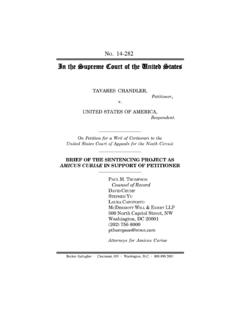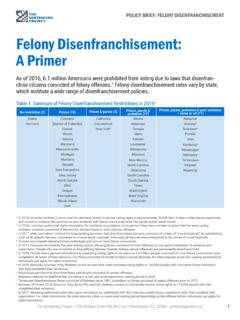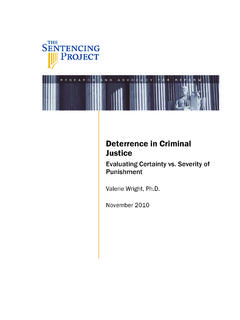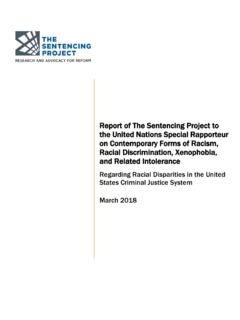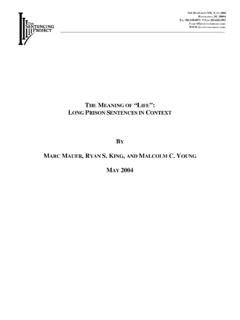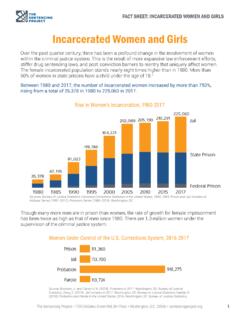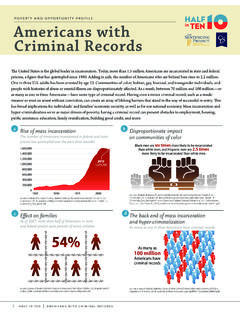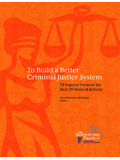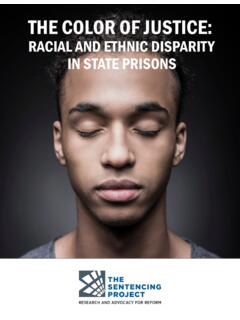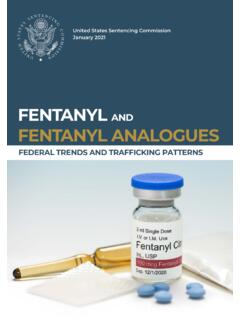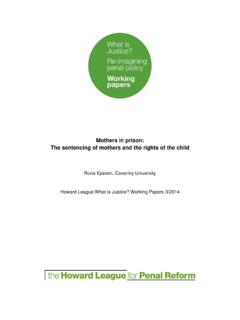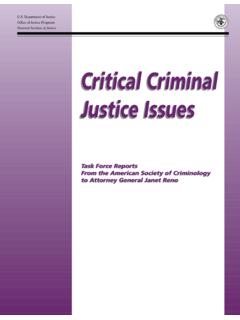Transcription of Reducing Racial disparity in the criminal Justice System
1 Reducing Racial disparity in the criminal Justice SystemA Manual for Practitioners and PolicymakersiABOUT THE sentencing PROJECT The sentencing Project is a national nonprofit organization which promotes sentencing reform and the use of alternatives to incarceration through program development and research on criminal Justice issues. The sentencing Project s research addresses the causes and consequences of Racial disparities, as well as prac-tical responses to these Racial disparity in the criminal Justice System : A Manual for Practitioners and Policymakers was first published in 2000 with a grant from the Bureau of Justice Assistance.* This second edition was produced by The sentencing Project in 2008 with the generous support of individual donors and foundations, including:About The sentencing ProjectMorton K.
2 And Jane Blaustein Foundation Bernard F. and Alva B. Gimbel Foundation Herb Block Foundation Open Society Institute Public Welfare Foundation Anonymous Donor at Rockefeller Philanthropy Advisors Sandler Family Foundation The Starfish Group Wallace Global FundFor more information contact:The sentencing Project 514 10th Street NW, Suite 1000 Washington, DC 20004 (202) 628-0871 This publication is available online at * The first edition of this publication (2000) was supported by Grant Number 98-DD-BX-0060, awarded by the Bureau of Justice Assistance. The Bureau of Justice Assistance is a component of the Office of Justice Programs, which also includes the Bureau of Justice Statistics, the National Institute of Justice , the Office of Juvenile Justice and Delinquency Prevention, and the Office for Victims of Crime.
3 Points of view or opinions in this document are those of the authors and do not represent the official position or policies of the United States Department of Racial disparity IN THE criminal Justice System We cannot run society for the privileged and allow a significant proportion of the population to be marginalized. It impacts the quality of life for all of us if we have throw away people. A Justice System which tolerates injustice is doomed to collapse. Leonard Noisette, Former Director, Neighborhood Defender Service of Harlem, NYWe, as a country, are confused about what we are trying to achieve with the crim-inal Justice System . The public needs to be moved away from the idea that the criminal Justice System can provide the answer to crime.
4 Indeed, our responses to crime often exacerbate the problem. criminal Justice agencies in a local jurisdiction must collaborate to get the proper message to the public and collectively say, this is what we can do, this is what we cannot do and then concentrate on improving the System particularly in the area of Reducing Racial disparities which result from our collective decision-making. I. Matthew Campbell, Former Assistant State s Attorney, Ellicott City, MDWhile the impact of incarceration on individuals can be quantified to a certain extent, the wide-ranging effects of the race to incarcerate on African American com-munities in particular is a phenomenon that is only beginning to be investigated.
5 What does it mean to a community, for example, to know that three out of ten boys growing up will spend time in prison? What does it do to the fabric of the family and community to have such a substantial proportion of its young men en-meshed in the criminal Justice System ? What images and values are communicated to young people who see the prisoner as the most prominent pervasive role model in the community? Marc Mauer, Race to Incarcerate1 Reducing Racial disparity in the criminal Justice SystemA Manual for Practitioners and Policymakers ivReducing Racial disparity in the criminal Justice System : A Manual for Practitioners and Policymakers represents the product of a collaboration among leaders from all components of the criminal Justice System .
6 Staff of The sentencing Project convened an advisory committee composed of criminal Justice leaders who provided information, participated in group discussions, and reviewed drafts of the manual. In addition, staff and consultants interviewed a broad range of criminal Justice practitioners nationally to solicit ideas and first edition of this manual was written by Dennis Schrantz and Jerry McElroy, and edited by Jenni Gainsborough and Marc Mauer. The second edition was written and edited by Ashley Nellis, Judy Greene, and Marc Mauer. Project Advisory Committee (First Edition, 2000)Charles Austin Chief of Police, Columbia, South CarolinaJames Bell Executive Director, W.
7 Haywood Burns InstituteI. Matthew Campbell, Jr. Assistant State s Attorney, Howard County, MarylandWilliam Carbone Director, Office of Alternative Sanctions, Rocky Hill, ConnecticutHon. Renee Cardwell Hughes First Judicial District, Court of Common Pleas, Philadelphia, PennsylvaniaAngela Jordan Davis Associate Professor, American University, Washington College of LawHon. Justin M. Johnson Superior Court of PennsylvaniaJolanta Juszkiewicz Deputy Director, Pretrial Services Resource Center, Washington, DCDr. Michael Lindsey Nestor Consultants, Carrollton, TexasJerome McElroy Executive Director, New York City criminal Justice AgencyLeonard Noisette Director, Neighborhood Defender Service, New York CityStuart O.
8 Simms Secretary, Maryland Department of Public SafetyJoseph Smith Executive Director, Indiana Commission on Community ServiceHon. Andrew L. Sonner Maryland Court of Special AppealsRobert Stewart Executive Director, National Organization of Black Law Enforcement ExecutivesAshbel ( ) Wall Director, Rhode Island Department of CorrectionsHubert Williams President, Police FoundationCopyright 2008 by The sentencing Project. Reproduction of this document in part or in full in print or electronic format only by permission of The sentencing OF CONTENTS Table of ContentsIntroduction ..1 What is Racial disparity ? ..1 The Impact of Racial I: Commonly Identified Causes of Racial disparity in the criminal Justice System .
9 5 Higher Crime Rates ..5 Inequitable Access to Legislative Overt Racial II: Manifestations of Racial disparity at Key Decision Points in the Justice Law Enforcement .. 11 Arraignment, Release and Pre-Adjudicatory Decisions ..13 Adjudication and sentencing ..14 Probation and Community-Based Alternatives to Jail and Prison Custody ..16 Parole and Reentry .. 18 Section III: A Research Design to Identify and Assess Racial IV: Strategies for Reducing Racial Law Enforcement .. 26 Pretrial ..30 Prosecution ..34 Defense ..38 Judiciary ..44 Jail and Prison Custody ..52 Parole and Administrative Options ..57 Conclusion ..62 The sentencing Project Board of Directors.
10 Designed for use as a reference manual for practitio-ners and offers strategies for assessing Racial dispar-ity. It also offers practices, procedures and policies to reduce disparity at each stage of the Racial disparity in the criminal Justice System is entirely consistent with a commitment to public safety and to a fair System of Justice . If un-warranted Racial disparities can be reduced, the jus-tice System will gain credibility and serve a more ef-fective role in preventing and responding to is Racial disparity ? Racial disparity in the criminal Justice System exists when the proportion of a Racial or ethnic group with-in the control of the System is greater than the pro-portion of such groups in the general population2.
